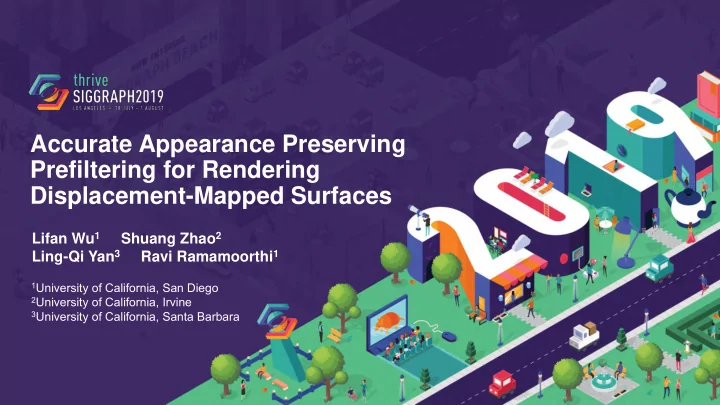

Accurate Appearance Preserving Prefiltering for Rendering Displacement-Mapped Surfaces Lifan Wu 1 Shuang Zhao 2 Ling-Qi Yan 3 Ravi Ramamoorthi 1 1 University of California, San Diego 2 University of California, Irvine 3 University of California, Santa Barbara
Realistic Appearance Models Simple surface Complex surface Image courtesy of Mitsuba [Jakob 2010]
Appearance Models with Rich Details [Jakob et al. 2010] [Zhao et al. 2011] [Heitz et al. 2015] [Khungurn et al. 2015] [Han et al. 2007] [Wu et al. 2011] [Yan et al. 2014, 2016]
Modeling Details Micro-geometry Micro-scattering Normal map (2D) + BRDF (Hemispherical) Disp. map (2D) Base shape Volume (3D) Phase function (Spherical)
Problems ray Complex light-surface interaction Micro-geometry Difficult to compute and analyze
Motivation • Camera zooming out ➔ less details are visible ➔ use coarser models [Zhao et al. 2016]
Our Goal • Prefilter high-resolution displacement maps + BRDFs • Preserve appearance ≈ Original Prefiltered
Prefiltering Distant views Coarser models representing aggregate micro-appearance Close-up views Match the desired appearance More and more details Precomputed before are aggregated rendering
Benefits • Anti-aliasing, storage reduction
Challenges • Difficult to accurately capture changes of illumination effects
Our Contributions General Anti- Accurate surface aliased
Background
2D Displacement Maps • Describe surface actual surface details (micro-geometry) • Need expensive super-sampling base surface patch Close-up views Distant views
Displacement mapping • Surface patch base surface patch • Micro-geometry
Prefiltering • Jointly handle changes of illumination effects • It is challenging due to non-linearity
Previous Work • Handle parts of illumination effects [Han et al. 2007] [Wu et al. 2011] [Iwasaki et al. 2012] Normal variation Normal variation + Normal variation + Shadowing-masking Shadowing-masking • Missing
Previous Work • Assuming certain types of surface (Gaussian/GGX/V-groove) [Olano and [Dupuy et al. 2013] [Heitz et al. 2016] [Lee et al. 2018] Baker 2010] [Xie and Hanrahan 2018] • Fail to generalize different Gaussian surfaces General surfaces
Previous Work • Iterative inverse rendering (optimization) is expensive
Our Approach vs. Previous Work General Method Interreflections Precomputation surfaces Bi-Scale No Yes Fast Microfacet Yes No Very fast Inverse Yes Yes Slow optimization Ours Yes Yes Fast
Effective BRDF Micro-geometry Micro-BRDF Effective BRDF
Effective BRDF • Weighted average BRDF over [Wu et al. 2011] [Dupuy et al. 2013] micro-BRDF cos term shadowing normalization term weighted by visible projected area
Our Approach
Overview Joint Appearance LoD prefiltering matching rendering • Joint prefiltering • Appearance matching ≈ ≈ Before prefiltering After prefiltering
Effective BRDF with Interreflections Without With interreflections interreflections
Effective BRDF with Interreflections Single-bounce contribution Multi-bounce path integral
Overview Joint Appearance LoD prefiltering matching rendering
Downsampling Displacement Maps Matching meso-normals High-resolution disp. map Low-resolution disp. map • Solved using least-squares
Overview Joint Appearance LoD prefiltering matching rendering
Step 1: Multi-Lobe SVBRDF • NDF: A (hemi-)spherical distribution of normal directions • Statistical representation: decorrelating positions and normals Micro-geometry Multi-lobe NDF NDF Image courtesy of [Heitz 2014]
Step 1: Multi-Lobe SVBRDF • Normal mapping [Han et al. 2007] • Multi-lobe BRDF = Multi-lobe NDF Micro-BRDF
Overview Joint Appearance LoD prefiltering matching rendering
Step 2: Scaling Function • Matching effective BRDFs • Computing the scaling function directly: • No need for iterative optimization • Not a practical algorithm
Overview Joint Appearance LoD prefiltering matching rendering
Efficient Factorization • Impractical to compute and store the full 6D scaling function • Rank-1 factorization
Efficient Factorization and can be tabulated coarsely (4 2 and 15 4 ) • • They can be reconstructed from sparse 6D samples
Efficient Factorization
Single Scale Joint Appearance LoD prefiltering matching rendering
Multi-Scale LoD Joint Appearance LoD prefiltering matching rendering • Prefilter at each mipmap level • Interpolate path contributions traced on different levels
Results
Scaling Function Resolution • Determine angular resolutions ( : 15 2 , : 15 2 )
Scaling Function Resolution • Determine spatial resolutions (uv: 4 2 )
Validations • Energy conservation • Synthetic two-color V-grooves
Accuracy Comparison
LoD Rendering
Changing Lighting/Viewing
Limitation / Future Work • Fail when the vertical displacements are large • Rely on model-dependent precomputation • Theoretical analysis of appearance prefiltering • Material editing
Future Work
Future Work • Machine learning + appearance modeling • Next talk! • Neural BTF Compression and Interpolation [Rainer et al. 2019] • Unified Neural Encoding of BTFs [Rainer et al. 2020] • …
Conclusion General Anti- Accurate surface aliased
Thank you!
Recommend
More recommend